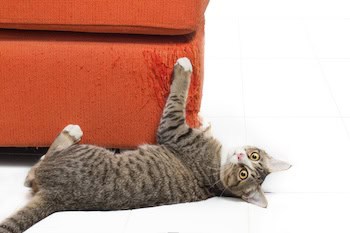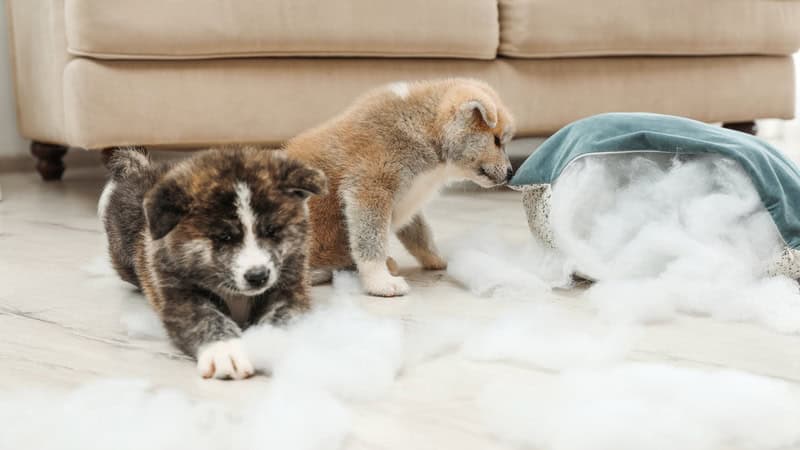Dog Chewing Challenges with a High-Energy Hound
A 3-year-old pup who us still shredding things, plus declawing alternatives

Some pups keep on chewing even after their puppy stage ends. Cathy M. Rosenthal of My Pet World shares tips on keeping a high-energy hound with dog chewing challenges happily engaged. Plus, declawing alternatives to protect both cats and furniture.
Dog Chewing Challenges
Dear Cathy,
My nearly three-year-old Basset Hound mix recently shredded my mileage sheet for last year’s taxes. Her chewing continues to be a challenge. She has a couple of indestructible Kong toys, but most chew toys are destroyed in minutes.
 She also tries to chew on the area rug tassels in the living room. I correct her, and she responds in the moment, but she eventually returns to the behavior. I keep her chew toys in an out-of-reach cabinet because her smaller toys repeatedly end up under the couch, though she has learned to obey when I tell her to play “away from the couch.” I am considering getting her an accessible toy box to solve this problem.
She also tries to chew on the area rug tassels in the living room. I correct her, and she responds in the moment, but she eventually returns to the behavior. I keep her chew toys in an out-of-reach cabinet because her smaller toys repeatedly end up under the couch, though she has learned to obey when I tell her to play “away from the couch.” I am considering getting her an accessible toy box to solve this problem.
She is a sweet, high-energy pup, but I’m struggling to effectively discourage these unwelcome behaviors. She also gets some doggie daycare time since I don’t have a yard. Because she’s a hound, she’s always leashed, and our walks are less frequent than they were when I got her in the spring. Thanks for any advice you can provide on our dog chewing challenges.
— Pat, Springfield, Vermont
Dear Pat,
It sounds like you’re doing so much right already, from providing extra toys, considering a toy box, and taking her to doggie daycare to burn off some of that energy. She’s obviously a very smart dog, and there’s a saying: If you don’t give a dog a job to do, he or she will become self-employed – and it seems she’s decided that chewing is her job.
To redirect her focus, I suggest adding puzzle toys to her routine. These toys have hidden compartments to hide treats, requiring dogs to figure out how to open them to retrieve the reward. Not only will this keep her mind engaged, but the mental effort often tires them out, which means she might enjoy a good nap afterward — a win for both of you.
A toy box that she can access is a great idea too, as it lets her pick and choose what she wants to play with that day. To prevent frustration, consider blocking gaps under the couch with pool noodles or furniture blockers so her toys stay accessible.
When it comes to discouraging her from chewing off-limit items like rug tassels, a pet-safe deterrent spray, such as Bitter Apple spray (available at pet stores or online), can make those items less appealing to her, thus eliminating some of your dog chewing challenges.
Combine this with redirecting her to appropriate chew toys and praise her with enthusiastic words or treats when she chooses the right option. This positive reinforcement will help her associate good behavior with rewards, making it more likely she will continue making the right choices.
It’s wonderful that she listens when you guide her away from certain behaviors, which shows she is responsive and trainable. So, introduce a little more training every day. You could reinforce already learned behaviors, like “sit” or “come,” or you could introduce something new. Teaching new tricks can help channel her energy in positive ways.
Armed with these tips, I’m confident you will be able to redirect her chewing habits and keep her happily engaged. Good luck with your dog chewing challenges!
Declawing alternatives
Dear Cathy,
 With all that has been stated about how harmful declawing is for cats, it is surprising that an alternative, nail clipping, never seems to be mentioned.
With all that has been stated about how harmful declawing is for cats, it is surprising that an alternative, nail clipping, never seems to be mentioned.
Clipping would reduce the damage that cats do to households and the cat’s anatomy would remain intact. Clipping would seem to be an acceptable alternative, unless there is a drawback that I am not aware of.
– Richard, Mineola, New York
Dear Richard,
You are right – trimming a cat’s nails is a simple, effective, and humane way to minimize damage to furniture and household items while preserving their anatomy. Though it won’t stop a cat from scratching altogether, it significantly reduces the harm and is a great alternative to declawing. The next question also offers a humane solution to this problem.
Dear Cathy,
I read your response to Geoffrey about declawing a cat. I have another humane suggestion for solving the problem of furniture scratching. There is a product called Panther Armor. It is a clear plastic with adhesive on one side that you apply to furniture where cats commonly scratch. It is claw-proof and works great.
— Dawn, Manchester, Connecticut
Dear Dawn,
Thank you for your suggestion. I looked into Panther Armor, and the plastic protectors look like a great option for keeping cats from scratching the furniture. This type of solution not only protects your belongings but also allows cats to express their natural behaviors without causing damage.
I appreciate you sharing this helpful tip. Practical, humane solutions like these make a big difference for many pet owners.
Cathy M. Rosenthal is a longtime animal advocate, author, columnist, and pet expert who has more than 25 years in the animal welfare field. She addresses reader questions as diverse as outdoor cat safety to bizarre dog behavior. Send your pet questions, stories, and tips to cathy@petpundit.com. Please include your name, city, and state. You can follow her @cathymrosenthal.
©2025 Tribune Content Agency, LLC
As an Amazon Associate, Boomer Magazine earns from qualifying purchases of linked products.


